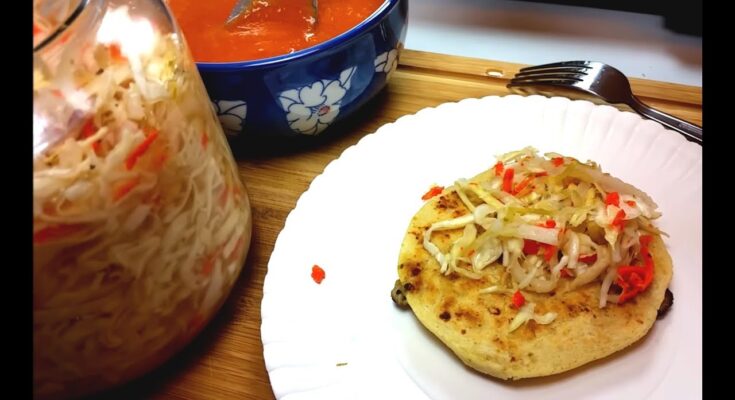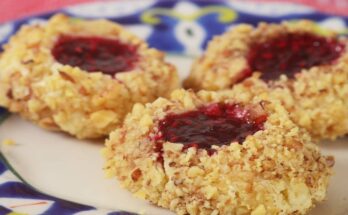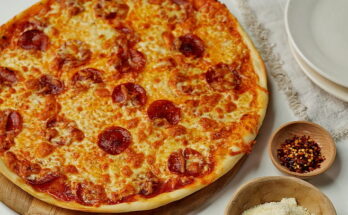Pupusa Recipe: Pupusas are a beloved traditional dish hailing from El Salvador, often considered a national treasure. These thick, handmade corn tortillas are stuffed with savory fillings like cheese, beans, and pork, then cooked on a hot griddle until golden and slightly crisp. The dish dates back centuries, with roots in the indigenous Pipil people’s cuisine, making it both delicious and deeply cultural.
What Makes Pupusas Unique?
What sets pupusas apart is their handcrafted nature and the use of masa harina—a special corn flour that gives them their distinct flavor and texture. They’re versatile, accommodating endless filling options, from traditional Salvadoran ingredients to modern, creative twists.
Ingredients Needed for Pupusas
Core Ingredients
To make authentic pupusas, you’ll need:
- Masa harina: This finely ground corn flour is essential for making the dough. Brands like Maseca are widely available.
- Water: Warm water is used to hydrate the masa harina and form a pliable dough.
- Fillings: Popular options include grated mozzarella or quesillo cheese, refried beans, and cooked, shredded pork (chicharrón).
Optional Ingredients for Variations
Feel like experimenting? Try these:
- Vegetables like sautéed spinach or zucchini
- Vegan-friendly options like plant-based cheeses or mashed lentils
- Sweet fillings such as Nutella or fruit preserves for dessert-style pupusas
Essential Equipment for Making Pupusas
Traditional Tools
- Tortilla press: While not mandatory, a press can make shaping pupusas easier and faster.
- Comal or griddle: This flat cooking surface ensures even heat distribution, crucial for achieving the perfect golden crust.
Alternatives for Home Kitchens
Don’t have traditional tools? No problem! You can use a flat-bottomed pan for shaping or a non-stick skillet for cooking. Even your hands and a rolling pin can work in a pinch.
Step-by-Step Guide to Making Pupusas
Preparing the Masa
Start by combining 2 cups of masa harina with 1 ½ cups of warm water in a mixing bowl. Mix with your hands until the dough is smooth and pliable but not sticky. If it’s too dry, add a tablespoon of water at a time. Cover the dough with a damp cloth to keep it from drying out.
Preparing the Fillings
Grate your cheese, mash your refried beans, or shred your cooked pork ahead of time. This makes assembly easier. Store fillings in separate bowls for easy access.
Shaping and Filling Pupusas
- Take a golf ball-sized piece of dough and roll it into a ball.
- Flatten it into a disk, about 4 inches in diameter, using your hands or a press.
- Place a small amount of filling in the center (don’t overfill!).
- Fold the edges of the dough around the filling and pinch to seal, forming a ball again.
- Gently flatten the filled ball into a thick disk.
Cooking the Pupusas
Preheat your comal or skillet over medium heat. Place the pupusas on the hot surface and cook for 2-3 minutes per side, or until golden brown and slightly charred. Flip carefully to avoid leaks.
Serving Pupusas
Accompaniments for Pupusas
No pupusa is complete without curtido, a tangy Salvadoran slaw made from cabbage, carrots, and vinegar, and salsa roja, a mild tomato-based sauce. These condiments balance the richness of the pupusas.
Tips for Serving Pupusas
Serve pupusas warm for the best experience. Pair them with a cold drink like horchata or tamarind juice to complement the flavors.
Common Mistakes to Avoid
Dough-Related Issues
The dough is the foundation of your pupusas, so getting it right is key. A common mistake is using the wrong water-to-masa harina ratio, resulting in dough that’s too dry or sticky. If the dough crumbles when you shape it, it needs more water. On the other hand, overly sticky dough may require a little more masa harina to firm it up.
Another pitfall is failing to rest the dough after mixing. Letting it sit for about 10 minutes helps hydrate the masa fully, making it more pliable and easier to work with.
Cooking Errors
Overcooking or undercooking pupusas is another common issue. If the heat is too high, the outer shell may burn before the inside fully cooks, leaving a raw taste. To avoid this, cook the pupusas over medium heat and be patient.
Leaking fillings can also be frustrating. This often happens if you overfill the dough or don’t seal the edges properly. Make sure to leave enough dough to completely encase the filling when sealing the edges.
Health Benefits of Pupusas
Nutritional Value
Pupusas can be a wholesome dish packed with nutrients. Masa harina, the base ingredient, is naturally gluten-free and a good source of fiber, iron, and magnesium. Fillings like cheese, beans, and pork provide protein, making pupusas a well-rounded meal.
Vegetable fillings, such as loroco or spinach, can add vitamins and minerals to your pupusas. Pair them with curtido, which adds probiotics and fiber to aid digestion.
Making Pupusas Healthier
Want to enjoy pupusas without overindulging? Use low-fat cheese or substitute regular pork with leaner meats like chicken or turkey. You can also swap traditional masa harina for a whole-grain version to boost fiber content.
For a lighter meal, consider making mini pupusas or serving them alongside a fresh salad to balance the richness of the dish.
Variations of Pupusas
Popular Regional Variations
In El Salvador, traditional pupusas include:
- Pupusas de Queso: Filled with melted cheese, this is one of the simplest and most beloved versions.
- Pupusas Revueltas: A mix of beans, cheese, and pork, offering a trifecta of flavors.
- Pupusas de Loroco: Featuring loroco, an edible flower with a slightly tangy taste, this variation is unique to Central America.
Modern Twists on Pupusas
Chefs and home cooks around the world have given pupusas a modern flair. Creative fillings like buffalo chicken, BBQ pulled pork, or vegan options with jackfruit are becoming popular.
Dessert pupusas are another fun variation, using fillings like chocolate, fruit jams, or caramel for a sweet treat. These are perfect for ending a meal or serving at a party.
Storing and Reheating Pupusas
Best Practices for Storing
If you make extra pupusas, don’t worry—they store well! Uncooked pupusas can be frozen by laying them flat on a baking sheet until firm, then transferring them to a freezer bag. Cooked pupusas should be stored in an airtight container in the refrigerator for up to three days.
Reheating Tips
To reheat, place cooked pupusas on a skillet over medium heat for 2-3 minutes per side. This method restores their crispness and warm, gooey filling. Avoid microwaving, as it can make the dough chewy and lose its texture.
If reheating frozen uncooked pupusas, thaw them in the refrigerator overnight before cooking as usual.
FAQs about Pupusas Recipe
Can I Make Pupusas Without Masa Harina?
Masa harina is essential for the authentic taste and texture of pupusas. However, if it’s unavailable, you can experiment with fresh masa or try a combination of cornmeal and all-purpose flour, though the result won’t be as traditional.
What’s the Difference Between Pupusas, Arepas, and Gorditas?
While pupusas, arepas, and gorditas are all corn-based dishes, they differ in preparation and origin. Pupusas are from El Salvador, stuffed and cooked on a griddle. Arepas, from Venezuela and Colombia, are typically split open and filled after cooking. Gorditas, a Mexican dish, are thicker and sometimes fried, with a pocket for fillings.
How Do I Prevent Pupusas from Leaking While Cooking?
To avoid leaks, don’t overfill the pupusas and make sure the dough completely encloses the filling. Pinch the edges well to seal and gently flatten without exposing the center.
Can Pupusas Be Made Vegan?
Absolutely! Use vegan cheese or mashed beans as a filling. For added flavor, include sautéed vegetables or plant-based meat substitutes.
Are Pupusas Gluten-Free?
Yes, traditional pupusas made with masa harina are naturally gluten-free. Just ensure that the masa harina you use is certified gluten-free to avoid cross-contamination.
Conclusion
Making pupusas at home is a rewarding experience that connects you to a rich cultural tradition. With a little practice, you can master the art of shaping and filling these delicious Salvadoran treats. Whether you stick to classic fillings like cheese and beans or venture into modern variations, pupusas are sure to be a crowd-pleaser.
Gather your ingredients, warm up your skillet, and enjoy the process of creating this iconic dish. Your taste buds—and anyone lucky enough to share your pupusas—will thank you!



